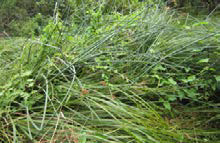Trip Report – 14 February 2015 : Centennial Reserve, Miramar
In the late Dr Geoff Park’s
Inventory of the Surviving Traces of the Primary Forests of Wellington City, 1999, he stated that kiekie is “a sound indicator of the survival of a primary forest element in the Wellington landscape ...”. Kiekie /
Freycinetia banksii is flourishing in the main valley in Centennial Reserve, at the north end of Darlington Rd. In 2004, after implementing intensive possum control on the entire Miramar Peninsula, Greater Wellington declared it to be possum-free. Maybe one day, the absence of possums, and the continuing control of rodents and mustelids in this 24.9-ha reserve, will enable the kiekie there to produce flowers and fruit.
Sara Free, a WCC councillor, joined our group gathered at the entrance. She had heard our personal submission on council’s draft
Suburban Reserves Management Plan, at a Council hearing on 12 February, and had expressed an interest in coming. We pushed through the ‘amenity’ plantings, tripping over masses of potato vine /
Solanum jasminoides and greater bindweed /
Calystegia silvatica. At the Tasmanian blackwoods, we left the track and crossed the tiny creek, passing luxuriant kiekie sprawling nearby, much of it reaching the canopy. Soon we reached the pre-1911 dam, and the silted-up wetland behind it which contains a mass of weeds, but also a healthy population of five (planted) carex species, and
Schoenoplectus tabernaemontani (=
S. validus) / kapungawha / lake club rush. We have yet to find out whether this sedge is naturally-occurring, or was planted there. Its stout, unbranched culms reach to 2 m. and are topped by side-mounted inflorescences. Among the 31 native species we added to the draft list of 74 was Gavin’s discovery of
Rubus squarrosus / yellow-prickled lawyer. We added 5 adventive species, including old man’s beard and English ivy, to the draft list of 21. Upstream of the dam, the valley narrows into a small gorge with a waterfall, a lovely, wild place, with a bluff, some large tree fuchsia, a big cabbage tree, and a huge mapou /
Myrsine australis.
 |
Schoenoplectus tabernaemontani.
Photo: Lynne Pomare.
|
The reserve contains at least 22 planted native species, several not recorded by botanist John Buchanan in 1872, during his survey of the indigenous and adventive vascular plant species of the entire Miramar Peninsula. We feel uneasy about these plantings. A community group, the Miramar Track Project, supported by WCC, has planted c. 2000 native plants, 500 from Berhampore Nursery, many from F&B’s Highbury nursery, and at least one commercial nursery. We wonder how these plantings will affect the ecological integrity of the reserve in the long-term, when they start to produce viable seed, and disturb the natural process of forest recovery. How will ecologists, botanists, and the managers of the land, deal with this situation?
In the ‘amenity’ planting, contiguous with the reserve, we found several inappropriate non-Wellington native species, e.g., puriri, which before long will invade this primary forest remnant, through bird action.
Coprosma linariifolia, also not naturally occurring in Wellington Ecological District 39.01, was planted here. This kind of unwise juxtaposition, i.e., plants selected for amenity-related reasons being planted on WCC road reserve immediately beside significant indigenous reserves / ecosystems, is all too common, threatening their ecological / botanical integrity. Wellington City’s remaining indigenous ecosystems are so few, so small, and so precious, that surely they should be considered as a ‘special-needs biodiversity’ category, meriting ‘special treatment’. We welcome WCC’s Restoration Technical Advisor, Anita Benbrook’s agreement to request that the Miramar Track Project remove inappropriate species from the reserve.
Participants: Bev Abbott, Sam Buckley, Gavin Dench, Michele Dickson, Sarah Free, Ian and Jill Goodwin, Jack Grasse, Richard Grasse, Mick Parsons, Lynne Pomare, Nick Saville, Sunita Singh, Val Smith, Sophie Williams, Barbara Mitcalfe and Chris Horne (co-leaders / scribes).

 Site Index
Site Index







 Site Index
Site Index





